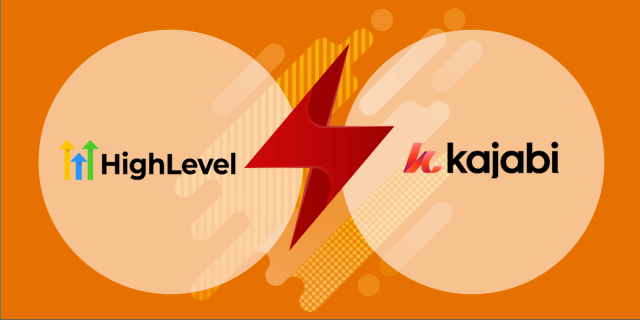The podcast market will be worth around $5.03 billion by 2027.
If you’re a consultant, business owner, course creator, coach, or digital marketer, now’s the perfect time to jump into podcasting!
You can use podcasts to promote your products and expertise.
And guess what?
You can even make steady passive income on the side!
So, what’s the catch?
Finding the right podcast hosting platform isn’t easy.
That’s why I’m breaking down 21+ podcast hosting platforms for you, highlighting what makes each one special.
By the end of this article, you’ll know exactly which one fits your needs.
But first, let me explain how I picked these platforms.
How did I select the best podcast hosting platforms?
New to podcasting?
You need a platform to create and host your content.
This content then gets distributed to places like Spotify where listeners can find you.
A podcast hosting platform lets you upload your podcast (or create one from scratch), edit it, add advertisements for passive income, check your analytics, distribute it, and more.
I used these key factors to select the best platforms:
- Storage and bandwidth
- Easy to create, upload, import, and edit
- Availability of multiple monetization options
- Detailed analytics
- Integrations
- Promotion and marketing capabilities
- Additional features for specific use cases (I’ll explain these in each review)
Based on these criteria, I’ve ordered my reviews starting with the highest-scoring platforms.
Best podcast hosting platforms – A quick glance
While I’ll review over 20 different podcasting platforms, here’s a quick look at the top 7 platforms that work for most people based on their specific needs.
| Product name | Starting price |
| Buzzsprout – Best for ease of use | $12/month |
| Podbean – Versatile | $14/month |
| Spreaker – Best for audience engagement | $20/month |
| Fusebox – Best podcast player | $9/month |
| Captivate – Best for multiple podcasts | $19/month |
| Transistor – Best for team collaboration | $19/month |
| Simplecast – Best for analytics | $15/month |
Upfront bottom line
After testing dozens of podcast platforms, here are my top picks:
- Buzzsprout: It’s one of the simplest podcast hosting platforms available today, making it a great choice for all users. It comes with features like Magic Mastering, transcriptions, a free podcast website, and automatic file conversion to help you easily create, upload, and edit your podcasts. The downside? It doesn’t have a mobile app.
- Spreaker: What makes Spreaker stand out is its Studio app that lets you create and edit podcasts on the go. It also supports live podcasts and offers in-depth analytics, especially in the higher plans. Want to make money right away? Spreaker’s extensive monetization options help you start earning from day one. Just remember, you won’t get a free website with this one.
- Podbean: Want to host video podcasts with powerful editing? Podbean is your answer. You can schedule episodes, use their built-in music and sound library, and even live stream to your audience. Their well-developed mobile app even allows you to merge or split recordings. Be prepared though – there’s a steep learning curve involved.
Let’s dive into the details of each platform!
Buzzsprout

Looking for a super simple podcasting tool packed with useful features?
Buzzsprout is exactly what you need.
What makes it stand out?
Its simplicity.
You can access any feature within just three clicks.
Everything is arranged logically, making it incredibly easy for beginners to navigate.
And there’s one feature we absolutely love: Magic Mastering.

This amazing filter lets you edit and process your audio files without any third-party tools.
Just upload your audio, and Buzzsprout automatically edits it to match industry standards (with zero quality loss).
Not an audio editor? This feature will be a game-changer for you.
Pricing

The free plan hosts episodes for up to 90 days only.
This means you’ll need to upgrade to keep your content forever.
Need to know: Buzzsprout’s highest plan supports only 12 hours per month. This won’t be enough if you plan to host long episodes and deep dives.
One more thing – you can host only one podcast show in all the plans.
Pros 👍
- Easy editing: The Magic Mastering feature optimizes audio uploads to meet industry standards, eliminating the need for third-party tools.
- Save time with dynamic ad insertion: It inserts dynamic ads automatically, saving you time and effort.
- Leverage AI features: Cohost AI supports the podcast creation process. It generates show notes, transcripts, and social media posts for your podcast episodes, saving time and effort.
- Transcribes every episode integrations: If you don’t want their AI addon, it integrates with Otter.ai and Temi to transcribe every episode.
- Robust affiliate marketplace: Has an affiliate marketplace for monetization. You can integrate custom brands as well.
- SEO-friendly: Comes with a free website that creates a blog post for every podcast episode you release.
Cons 👎
- Lacks a mobile app: Lacks a mobile app for both podcasters and listeners.
- No live streaming: Doesn’t support live streaming of podcasts
- Doesn’t support video podcasting: You can’t create video podcasting.
- Only basic analytics: It offers statistics like the number of downloads, the demographics of your audience, and the most popular episodes. You don’t get retention reports as you get with say Podbean.
🏆 Bottomline: Buzzsprout checks all the boxes for a beginner podcast producer’s needs. It’s also suitable for advanced podcasters because of its easy-to-use dashboard, straightforward tools like magic mastering, integration with tools like Canva, Otter.ai, Temi, SEO capabilities, etc.
If you are interested you can read my detailed review of BuzzSprout.
Podbean

Podbean stands out as one of the best tools for advanced podcasters.
Just like Spreaker, Podbean gives you a mobile app for both podcasters and listeners.
The app supports in-app purchases which helps boost your sales. This is honestly one of Podbean’s biggest strengths.
What I really like is how flexible Podbean is for managing multiple podcasts from one account.
You can create unlimited premium podcast channels.
And here’s the best part – Podbean doesn’t charge you for storage or downloads. They only take a percentage of your sales as fees.
Another feature I can’t stop talking about is their free podcast audio recording app.
With this app, you can create and publish studio-quality podcasts from anywhere in the world.
You can add rich background music, edit your recordings, add intros and outros, and publish your episode with just a few clicks.

Creating or editing podcasts couldn’t get any easier than this! And it works on both iOS and Android devices.
Let’s talk about making money with your podcast.
Using Podbean, you can sell ad spots, merchandise, and even use their built-in donation feature.
The platform also offers something called “Premium Podcasts,” which lets you create exclusive content and charge a subscription fee for your listeners to access it.

Another standout feature of Podbean is its automation.
All you need to do is create your ad campaign.
Podbean handles everything else – finding the right spots for ads, scheduling campaigns, and tracking impressions.
This saves you tons of time and effort!
Pricing
Podbean gives you a free trial with up to 5 hours when you sign up.
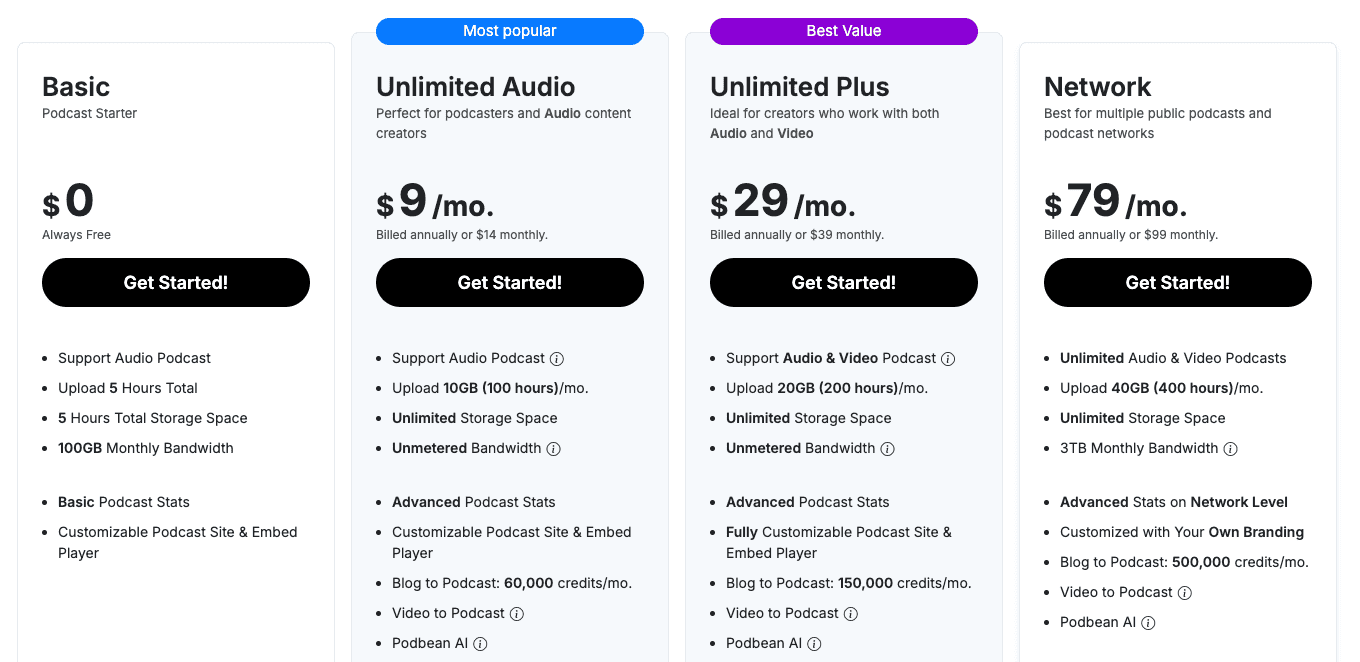
After that, you’ll pay a minimum upload plan of $9 per month (annual billing) or $14 per month (monthly billing).
I think that’s great value for what you get.
Pros 👍
- Wide range of integrations: Comes with various free plugins (for transcripts, SEO meta tags, Google Analytics integration, etc.) to boost the tool’s functionality.
- Comes with an affiliate ad marketplace: Has an affiliate ad marketplace where you can find and promote sponsors.
- Unlimited hosting: No limits at all!
- Free website: All plans include a free website with customizable templates. You can even connect your own domain.
- Supports live streaming: Record your podcast and go live, but be aware that quality might suffer since Podbean doesn’t work with lossless file formats.
- Offers detailed analytics: Provides easy-to-read stats like downloads by time and day, listener demographics, top episodes, and more. This helps you tailor your content to your audience.
- Built-in music library: Make your podcasts better with their built-in music and sound effect library.
- A simple interface: Features a simple drag-and-drop interface that’s easy to navigate. This makes creating and editing podcasts fun and straightforward.
Cons 👎
- Video podcasting can be expensive: This feature is only available in the higher-priced plans.
- No backups: There’s no way to create podcast backups.
🏆 Bottomline: Podbean is a powerful tool with various free plugins to extend its functions. Its Patron program, PodAds integration, ad marketplace, and mobile apps make it worth every rupee.
Spreaker
Spreaker stands out as one of the best podcast hosting platforms available today.
It’s a complete end-to-end podcasting solution where you can record, edit, publish, analyze, and monetize your podcast all in one place.

When I look at Spreaker, two things really grab my attention: monetization and the mobile app.
Let’s talk about monetization first.
Spreaker focuses on programmatic advertising.
It finds fresh, relevant ads for you without any effort on your part.
To make things super easy, they’ve built a dedicated ad campaign manager where you can set up, manage, and track all your ad campaigns in one place.
Plus, it integrates with Patreon if you want to sell products and merchandise.
The mobile app is another standout feature.
Spreaker offers apps for both listeners and podcasters.
For podcasters, there’s a dedicated studio app that lets you record, edit, and publish episodes while you’re on the go.
If you travel frequently and need to manage your podcasts from anywhere, Spreaker is your best bet.
Pricing

As you can see, monetization is built into every plan, even the free one.
You might only get one podcast, but you can still make money from it.
The higher plans naturally give you more control and features.
What’s the catch?
Spreaker takes a 40% commission on your ad revenue per impression. That’s a big chunk!
But honestly, even Google takes a similar cut with AdSense. So it’s not a big deal for me, especially since you can start making money right away.
Pros 👍
- Supports live podcast: You can broadcast live from anywhere. Better yet, you can use the chat feature to engage with your audience in real time.
- Built-in recording: Record directly with the studio app. It even integrates with Skype for guest interviews.
- Wide variety of music clips and sound effects: Choose from lots of music and sound effects to enhance the listening experience for your audience.
- Comes with a well-designed player: It has a customizable player you can embed in your websites. Embed it using an iframe tag or with a tiny JS loader.
- Insert dynamic ads: Put ads anywhere in your podcast – pre-roll, mid-roll, or post-roll. Do it manually or let Spreaker find the optimal locations for you.
- Allows multiple shows: Run multiple shows on one account, giving you tons of flexibility.
- Enables repurposing content into ebooks: Turn your podcasts into ebooks and sell them separately.
Cons 👎
- No free website: Unlike Buzzsprout, you don’t get a free website.
- No custom CTAs in player: You can’t add custom CTAs to your player. Fusebox is the only one that offers this feature.
- Doesn’t support video podcasting: No video podcasting support, so you miss out on the personal connection that comes with letting listeners see you!
🏆 Bottomline: If you need programmatic ad monetization and access to a dedicated ad campaign manager, Spreaker would be the best choice. Its Studio app helps you record the episodes, edit them, and publish them on the go. If you are interested in exploring more on if Spreaker is the right tool for you, do refer my indepth review of Spreaker.
Fusebox

Fusebox is one of the few podcast hosting platforms that lets you display your podcast transcripts on your WordPress website.
It was started by Pat Flynn, the host of the blog and podcast called Smart Passive Income which has millions of subscribers worldwide.

By looking at the app name, you can quickly understand that this platform was initially designed to be a podcast player that can be embedded on your website.
After its success, it has also introduced podcast hosting capabilities.
Its uploading interface is simple and you can upload and edit content easily.
You can even migrate podcast episodes from other platforms without any hassle.
Pricing
Its pricing is simple and straightforward.

If you’re a pro podcaster, it’s a good value for your money.
Pros 👍
- Generates episode transcripts: Automatically generate transcripts for all your episodes.
- Provides detailed analytics: Provides information on downloads, rankings by source and platform, top-performing episodes, and more.
- Comes with extensive documentation: Comes with an extensive library of articles to answer all questions.
- Offers a customizable player: The player is highly customizable and even comes with social sharing buttons for quick sharing across your social media platforms.
- Has well-designed skins: You can choose from its well-designed skins to make podcasts a visual treat as well for your listeners.
Cons 👎
- Limited customer support: Live chat is available only from Monday to Friday. Email support is available only on higher plans.
🏆 Bottomline: Fusebox comes with a highly customizable player that not only looks great but also allows you to add custom CTA buttons. Otherwise, the creation and edit options are limited.
Captivate
Captivate is a UK-based company with a clean, straightforward interface that lets you create and manage unlimited podcasts in a single account.
No limits on uploads or storage here.
No feature restrictions either.
You pay based on downloads – a fresh approach to podcast hosting.

The best thing about Captivate?
It comes with Growth Labs that gives you all the resources to learn podcast marketing.
You also get access to its community.
And guess what? Growth Labs is free for all Captivate users.
You’ll save time and money by using Captivate’s editing plug-ins instead of buying third-party editing software.
Distributing your podcast is super easy with Captivate. The platform includes a simple copy-and-paste feature for links to podcast distribution platforms.

It also comes with a built-in marketing suite where you can generate an automatic sponsor kit to share with potential sponsors.
Plus, the marketing links page serves as a central hub to manage all your promotional links – a handy way to track your marketing efforts.
Pricing
The pricing plans vary depending on the number of podcast downloads.
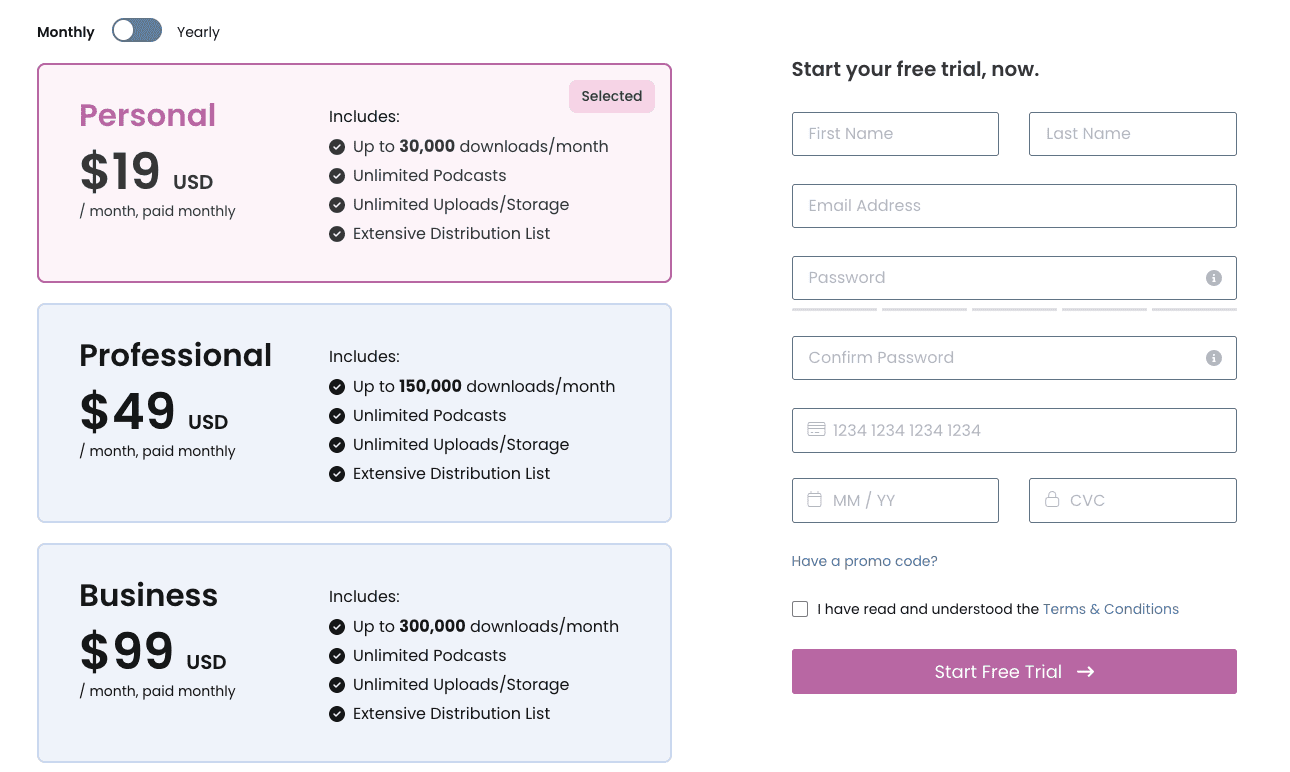
Captivate’s paid plans start at $19 per month.
It’s a bit more expensive than other platforms, but trust me, the benefits are worth every penny.
Pros 👍
- Supports private podcasts: Supports private podcasting to sell premium content. You can sell unlimited premium podcasts.
- Provides a WordPress plugin: It has a dedicated WordPress plugin to publish on your own website.
- Curated playlists with Collections: Another feature I use a lot is Collections. With this feature, you can create curated playlists for your listeners. You even have the option to include an embeddable media player as part of your collection. A cool feature to add value to your listeners.
- Podcast distribution across many platforms: A comprehensive list of podcast distribution platforms that integrate easily with Captivate.
- No limits on members: You get unlimited podcasts. Also, you can add any number of members to your team.
- Provides centralized control: The dashboard is intuitive and provides all the information you need to monitor the performance of your podcast and the marketing campaigns associated with it.
- Easy to create a podcast network: With Captivate, it’s easy to create a podcast network, right from the dashboard for a wider reach. No additional cost for you.
- Free website: You get a free website with any plan.
Cons 👎
- No free plan: Lacks a free plan, unlike Buzzsprout and Podbean.
- No ads marketplace: Lacks ad marketplace for monetization. To promote the ads you need to search on your own.
🏆 Bottomline: If you need to run more than one podcasting show, Captivate is the best bet. It gives you all the resources to master your podcasting career. So, it is the best solution for beginner podcasters who have no idea how to start podcasts.
Transistor

Transistor is one of the most trusted podcast hosting platforms out there.
What makes it stand out?
You can host as many shows as you want with just one plan!
Want to run multiple podcasts? No problem.
Transistor lets you manage everything from a single account.
Need to work with a team? You can add multiple hosts and guests and give each person different roles and permissions.
This makes Transistor perfect for teams that need to work together regularly.
But that’s not all.
It connects with tons of third-party tools too.
Think social media platforms, email marketing services, and website builders. Everything you need to grow your podcast is right there.

I’ve been using Transistor myself, and I love its analytics. The clean dashboards make it super easy to understand how my podcasts are performing.
Pricing

The pricing is simple with three plans. You can try it out with a 14-day trial.
The premium pricing starts at $19 per month.
Honestly, Transistor pricing is quite high when you compare it with tools like Spreaker and Buzzsprout.
Pros 👍
- Converts to MP3 files: Automatically converts audio files to MP3.
- Dynamic audio insertion: You can dynamically insert audio anywhere in your podcast to promote your sponsors.
- Supports private podcasts: Supports the creation of private podcasts for additional monetization.
Cons 👎
- No video podcasting: It doesn’t support video podcasting.
- Imposes download limits: Though it offers unlimited storage, there’s a constraint on the number of downloads.
🏆 Bottomline: Transistor is a platform focused on brands and entrepreneurs who want to optimize their costs, which translates into good value for money. It also works well to conduct corporate training sessions.
Simplecast
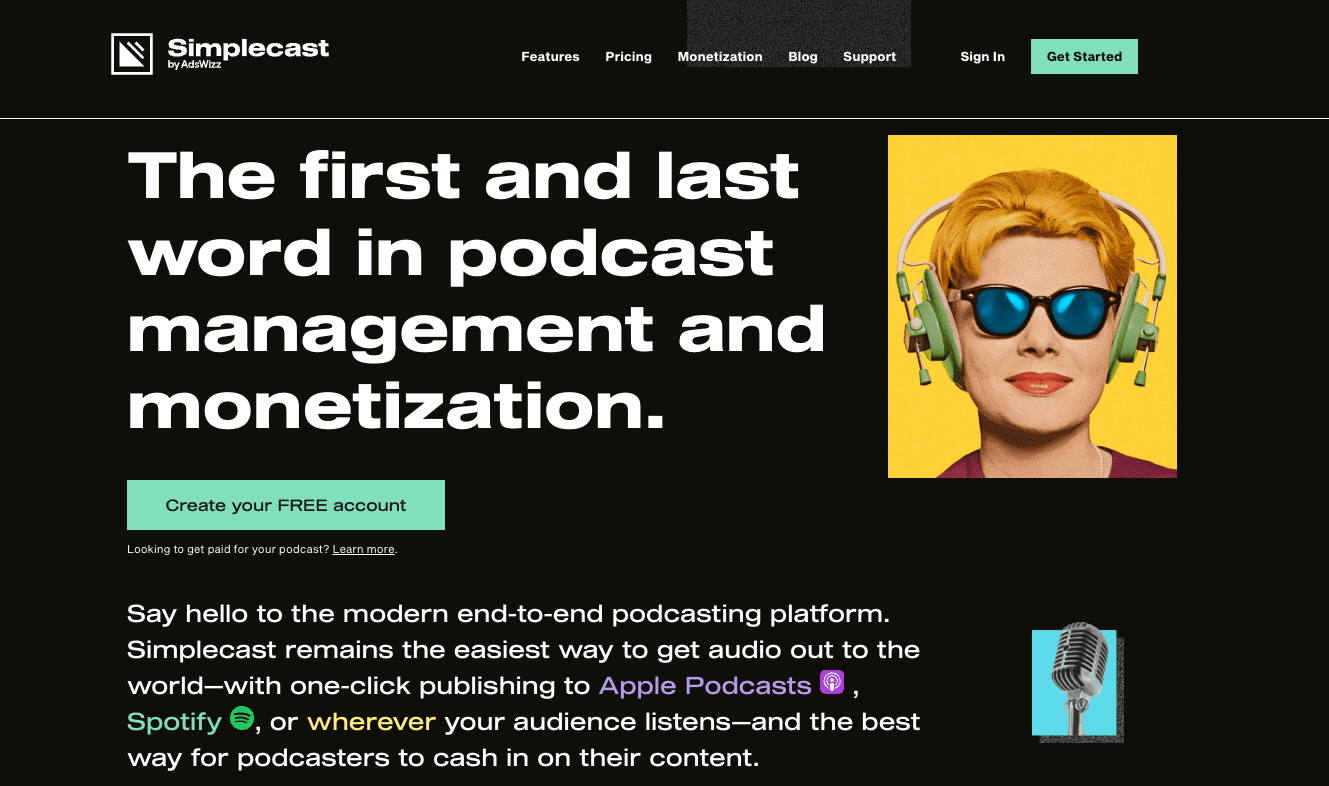
Simplecast has a more detailed sign-up process than most.
This helps you create specific content, but might not be great for beginners who need extra guidance.
Want to make your podcast more appealing? You can add custom images to catch your audience’s attention.
One of the best features? Simplecast gives you a customizable website. This means you can market and share your shows without needing any third-party tools.
Pricing
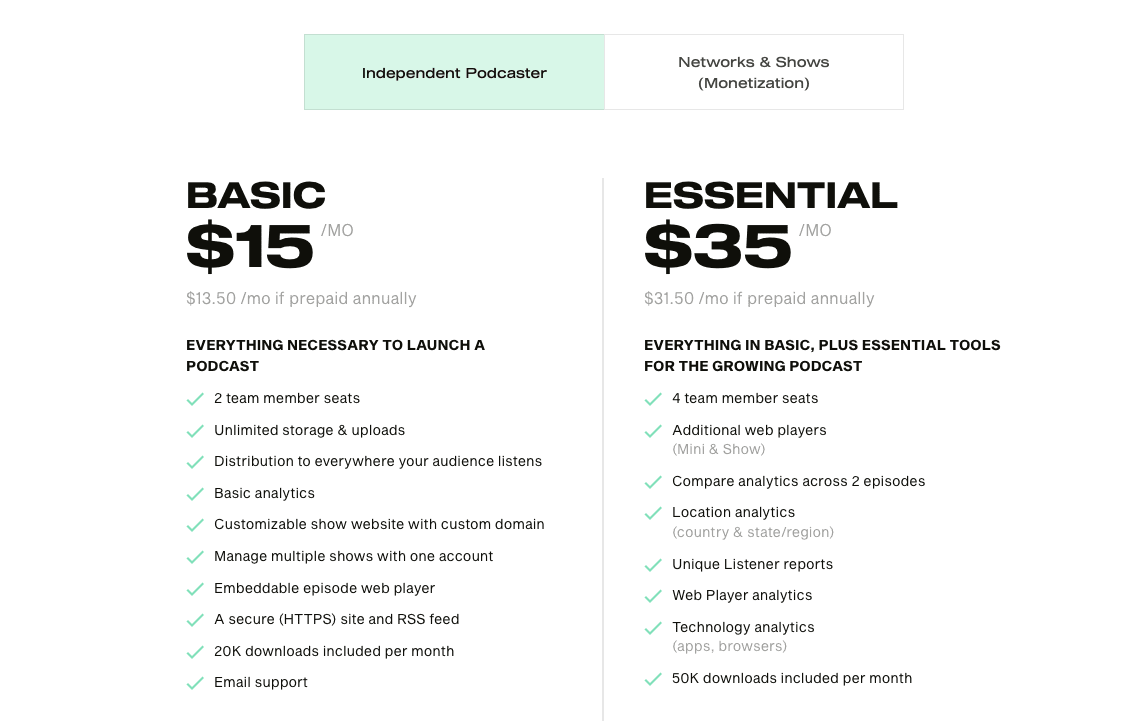
Simplecast offers a 14-day free trial.
After that, you can upgrade to a paid plan with unlimited uploads for just $15 per month.
This makes a lot of sense if you plan to create tons of content or have co-hosts on your show.
Pros 👍
- Allows multiple shows: Allows you to create multiple podcasts in a single account.
- 1-click publishing: Enables you to publish with just one click.
- Supports migration: Supports the migration from other platforms.
Cons 👎
- No video podcasting: No support for video podcasting.
- Restrictive download limits: The download limits are restrictive.
🏆 Bottomline: Simplecast stands out for podcasters who care about detailed analytics. You’ll get much more data than most other platforms offer. It’s easy to use and lives up to its name. But be aware – it’s a bit expensive for what you get.
Libsyn

Libsyn is one of the few podcast-hosting platforms that support both audio and video podcasting. However, it doesn’t have recording or creating capabilities, so you can only upload recorded podcasts to it.
That said, it comes with a custom iOS and Android app and multiple monetization streams. Its Canva integration is another plus. Libsyn also offers many monetization streams like ads, subscriptions, and donations. It offers good customer support as well.

The plan limits are slightly different from the other platforms. At first glance, the low storage limits can be put off, but note that this is only for the new content that’s added every month. This way, there’s no limit on the number of podcast shows you host on Libsyn.
Blubrry

Blubrry is an all-in-one podcasting tool that comes with almost all the features built inside it. It has a PowerPress plugin, which allows you to easily integrate and launch your podcast if you have a WordPress website.
Along with this, it provides a free landing page to promote your podcasts and attract leads.
Similar to tools like Podbean, it supports private podcasts. You can even create premium memberships and restrict access to paid members.
Blubrry is easy to use and makes it convenient to distribute to podcasting directories. Its advanced and IAB-certified statistics are a great addition as well.

Blubrry offers a 14-day free trial with up to 400 MB of storage per month.
Although Blubrry is easy to use, it may not be suitable for your content if you want to host multiple shows, as storage is limited.
Acast

Acast is another good choice for creating, editing and distributing your podcasts. A highlight of this tool is its free access to Podcastle, a browser-based podcast editor that is highly intuitive to navigate and use.
You can use this tool to convert your podcasts into videos and share them seamlessly on social media. Also, you can add comments from Disqus or Facebook, and even include links to your other podcast platforms.

Note that there are no limits to hosting or downloads, making it a good value for money.
Overall, Acast is an all-round platform for podcasters of all skills and experience. That said, its features are basic and don’t offer the flexibility of Spreaker or Buzzsprout.
bCast

bCast is a podcast creation and distribution platform geared for high-growth podcasts and large businesses.
It comes with many features like audio inserts for including compelling audio CTAs in your podcast. Similarly, its auto opt-in feature also helps to bring more subscribers to your podcast, join your newsletter, etc.
Transcription and one-click submissions are other notable features.
bCast’s plan starts at $15 per month and it supports only one podcast. Also, it’s restricted to 10,000 downloads per month. The unlimited plan can set you back by $75 every month, making it one of the most expensive choices today.
RSS.com

RSS.com has a simple sign-up process. All you need to do is enter your email address and you are ready to go.
If you are an NGO and want to monetize your content to raise funds, RSS.com offers an NGO plan that is subsidized starting at $5 per month with several benefits like unlimited episodes and uploads.
It even comes with a free website and the ability to schedule podcasts.
Audioboom

Audioboom is listener-focused rather than download-focused. With as few as 10,000 downloads per month, you have access to advertising sponsorships and brand partnerships that can easily be monetized as your podcasts gain popularity.
Audioboom does not have a free trial period. However, if you cancel your subscription within the first month of your standard plan, you will receive a full refund.
With the standard $9.99 per month subscription, you can upload unlimited episodes and reach up to 10,000 listeners per month. The higher tier for $19.99 per month equates to 25,000 listeners per month.
Resonate

Resonate is a podcast recording platform that is also a hosting platform.
This is very important because it allows you to edit, produce, and upload your shows to the same platform at the same time.
However, the pricing for Resonate can be a bit high, as monthly plans start at $25. This will come in handy only if you plan to produce multiple shows in a month.
Castos

With Castos you can turn your shows into articles and posts. That’s possible because Castos provides automated transcription services, maximizing the value of your content.
Castos has a quick and easy sign-up process. All you need is your email address and password.
Castos offers an unlimited free trial period of 14 days. After that, you get unlimited upload and download for about $15 per month.
You also get easy integration with WordPress for your transcriptions, automated transcription, and distribution on Spotify and Amazon Music.
Podserve.fm

Podserve.fm prides itself on doing all the work for you, so you get the most bang for your buck. All you need is to record your podcast and upload it.
The transcription services offered on Podserve.fm are of high quality. If you want, you can also publish your podcasts as posts. Podserve.fm is worth considering.
Podserve.fm offers a 14-day trial period, after which you can sign up for the paid subscription for $19 per month.
Anchor.fm

If you want to start creating and uploading shows but have a zero budget for it, Anchor is the place for you.
Anchor is a widely known free podcast hosting platform that also has a mobile app, similar to Podbean or Spreaker. This means that you can create and upload your shows from both your mobile and desktop, all for free. Great, right?
You can use Anchor to distribute your shows on some of the most popular podcast distribution platforms like Google Podcast, Amazon Music, and Spotify.
However, you’ll be at a slight disadvantage if you want to monetize your shows. That’s because Anchor requires you to insert too many paid ads into your podcast episodes, which can be unpleasant for your listeners.
Anchor, therefore, may not be the right place for you if you want to take podcasting seriously.
Squadcast

SquadCast main selling point is the production of high-quality videos and audio. This is because SquadCast has built-in edit software to help you produce the best quality video and audio.
Squadcast is the ideal platform for YouTubers who are also looking for a podcasting solution.
Squadcast is also designed as an end-to-end incident management software that helps you promote Site Reliability Engineering (SRE).
For $10/month, you can get 2 hours of uploads to Squadcast. For $150/month, you get 25 hours of uploads. What’s more, if you want to try everything the platform has to offer, you can try it for free for 7 days.
Ustudio

Ustudio is a platform that’s specifically geared towards businesses and meeting their needs.
One of the unique features of Ustudio is that it allows you to host private podcasts. This can be a valuable tool for communicating with a specific group of people such as employees or a particular niche of customers/listeners.
However, the signup process with Ustudio can be a bit tedious, especially if you do not have a business or work in one.
PodOmatic
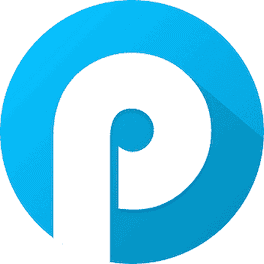
PodOmatic is undoubtedly one of the most affordable podcast hosting platforms.
You will get a customizable website that lets you personalize your podcast page and the option to monetize your podcast through paid advertising and funding from patrons.
If you just want to get started without worrying about costs or monthly fees, definitely check out PodOmatic.
With the basic package, you can set up accounts for free and still get up to 15 GB of bandwidth per month and 500 MB of storage for two months. That should be adequate as you consider staying on the platform or trying out other platforms.
The Pro plan starts at a low fee of $2.99, for which you get 100 GB of bandwidth per month and 2 GB of storage.
Fireside

If you are completely in the dark about how podcast hosting platforms work, Fireside is one of the places to start.
Fireside, interestingly enough, offers a video showcasing the best features on its home page. This helps you quickly figure out if it’s the right platform for you. If it’s not, then you save the time that you could have spent signing up.
Fireside offers a 14-day trial period when you sign up for their paid plans, which start at $9 for hosting a single show with 100 MB of storage.
You can request for your subscription money to be refunded if you decide to cancel before the 14-day trial period expires.
The higher tier costs $49 per month and allows you to host up to two podcast shows with 200 MB of storage. This can be limiting if you want to experiment with more shows than that.
Bottomline
How do you choose a good podcast hosting platform? The answer lies in your needs as a podcaster.
My top 3 recommendations are Buzzsprout, Spreaker, and Podbean
Choose Buzzsprout if you –
- Are a beginner and you need a simple tool to get started.
- Need podcast editing features right inside the tool
- Want various monetization strategies.
Choose Spreaker if you need –
- Mobile apps for creating podcasts
- A built-in programmatic ad monetization
- A dedicated ad manager
Choose Podbean if you want –
- Advanced analytics to better understand your audience.
- Monetize your podcast and offer premium content to your subscribers.
- Create live streams from your dashboard
These vary depending on your requirements, but I hope this information has given you enough insight to choose the ideal podcast hosting platform for you.




